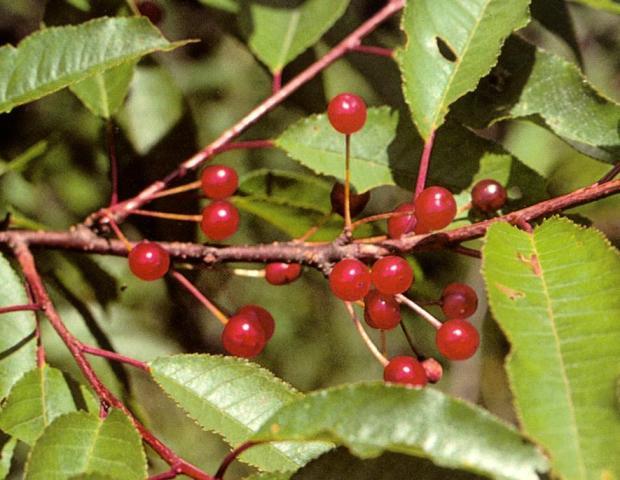Pincherry Production in Manitoba
Description

The pincherry (Prunus pensylvanica L.) belongs to the rose family. The pincherry is native to Canada and found as far north as Great Slave Lake making them vary winter hardy. The pincherry is a small tree or large shrub which can reach a height of 20 feet (6 m) under excellent growing conditions, but usually shorter. Blooms are produced in early June in clusters with five to seven flowers in each cluster. The fruit is small and bright red when ripe and contains a large stone inside.
There has been some selection of wild plants or breeding that has resulted in the identification of a plant with double flowers and another with fruit three times as large as the usual pincherry.
Uses
Pincherries can be used to make jellies, juice, syrup, wine, sauce and components of baked goods such as muffins, cakes, cookies and fruit bread. They can also be used to make ice cream and pies. Pincherries can be stored, frozen, dried or canned.
Site Selection/ Spacing/Rooting Depth
Pincherries, like other small fruit, requires a well-drained, deep loam soil which contains greater than one percent organic matter. They require full sun and will not tolerate shading. A soil pH of between 5 and 8 should be suitable for growing pincherries.
Plants should be spaced six feet (2 m) between plants and 15 feet (4.5 m) between rows to facilitate mechanical harvesting. Detailed information about rooting depth is not known however, but because the plant prefers a moist environment it is likely they are not deep rooted.
Harvesting/Nutritional Value
The fruit ripens during the summer and is ready to be picked from August to September. The fruit is small which makes hand picking difficult. Hand held harvesters can be used and under orchard conditions with controlled plant size, mechanical harvesters can also be used. The nutritional value of the fruit has not been determined but it does contain many vitamins and minerals.

